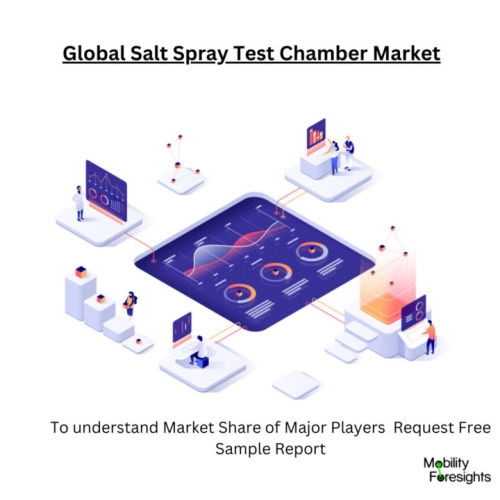
- Get in Touch with Us

Last Updated: Apr 25, 2025 | Study Period: 2024-2030
In order to assess the rust resilience of materials and surface coatings, electrical apparatus manufacturers frequently use a salt spray test chamber, also referred to as a salt fog chamber or salt spray tester.
The Salt Spray Test simulates the impacts of prolonged exposure to harsh climatic conditions, such as seawater spray or high humidity, by subjecting a sample to a highly corrosive saltwater solution. The sample is put inside the Salt Spray Test Chamber, which is kept at a specified temperature and humidity level while being continuously misted with a regulated amount of saline solution.
The Salt Spray Test can last anywhere between a few hours and several weeks, based on business norms and requirements. The sample is examined for any corrosion indicators, such as staining, rust, or pitting, after the test has been finished.
The electrical machinery industry benefits from the use of the salt spray test chamber because it enables manufacturers to assess the robustness and dependability of their products in challenging conditions and carry out the necessary adjustments to make sure that their products adhere to industry standards and meet the needs of customers.

The Salt Spray Test Chamber accounted for $XX Billion in 2023 and is anticipated to reach $XX Billion by 2030, registering a CAGR of XX% from 2024 to 2030.
In order to assess the corrosion endurance of materials and coatings, Q-Lab Corporation, a top supplier of accelerated weathering and corrosion testing tools, has introduced a new Salt Spray Test Chamber. In accordance with industry standards like ASTM B117 and ISO 9227, the Salt Spray Test Chamber is a cutting-edge piece of apparatus.
The chamber has a double-wall structure that consists of an interior liner made of premium stainless steel and an exterior casing made of fiberglass reinforced plastic (FRP), which renders it long-lasting and corrosion-resistant. An automatic system for delivering salt solutions guarantees exact and constant salt spray conditions throughout the test run in the container.
It also includes a touchscreen UI that makes it simple to program me and keep track of test factors like temperature, humidity, and exposure duration. Numerous testing uses, including pre-treatment assessment, material selection, quality control, and research and development, can be performed in the salt spray test chamber with a variety of test specimens.
It can be used to evaluate materials and coatings for the automobile, aircraft, maritime, and other sectors that frequently work in harsh environments. In order to satisfy its customers' testing requirements, Q-Lab Corporation is dedicated to offering them top-notch testing tools and services.
In conclusion, Q-Lab Corporation's Salt Spray Test Chamber is a great addition to the testing apparatus the business offers. It is a valuable commodity for companies in various sectors because it is a dependable and effective instrument for assessing the corrosion resistance of materials and coatings under severe saline spray circumstances.
| Sl no | Topic |
| 1 | Market Segmentation |
| 2 | Scope of the report |
| 3 | Abbreviations |
| 4 | Research Methodology |
| 5 | Executive Summary |
| 6 | Introduction |
| 7 | Insights from Industry stakeholders |
| 8 | Cost breakdown of Product by sub-components and average profit margin |
| 9 | Disruptive innovation in the Industry |
| 10 | Technology trends in the Industry |
| 11 | Consumer trends in the industry |
| 12 | Recent Production Milestones |
| 13 | Component Manufacturing in US, EU and China |
| 14 | COVID-19 impact on overall market |
| 15 | COVID-19 impact on Production of components |
| 16 | COVID-19 impact on Point of sale |
| 17 | Market Segmentation, Dynamics and Forecast by Geography, 2024-2030 |
| 18 | Market Segmentation, Dynamics and Forecast by Product Type, 2024-2030 |
| 19 | Market Segmentation, Dynamics and Forecast by Application, 2024-2030 |
| 20 | Market Segmentation, Dynamics and Forecast by End use, 2024-2030 |
| 21 | Product installation rate by OEM, 2023 |
| 22 | Incline/Decline in Average B-2-B selling price in past 5 years |
| 23 | Competition from substitute products |
| 24 | Gross margin and average profitability of suppliers |
| 25 | New product development in past 12 months |
| 26 | M&A in past 12 months |
| 27 | Growth strategy of leading players |
| 28 | Market share of vendors, 2023 |
| 29 | Company Profiles |
| 30 | Unmet needs and opportunity for new suppliers |
| 31 | Conclusion |
| 32 | Appendix |